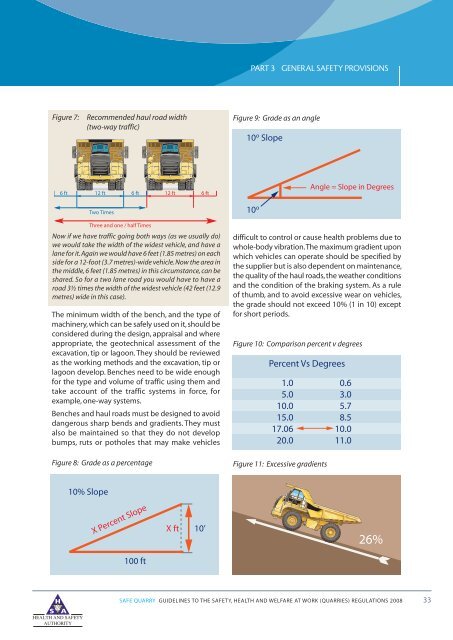Safe Quarry - Health and Safety Authority
Safe Quarry - Health and Safety Authority
Safe Quarry - Health and Safety Authority
You also want an ePaper? Increase the reach of your titles
YUMPU automatically turns print PDFs into web optimized ePapers that Google loves.
PART 3<br />
GENERAL SAFETY PROVISIONS<br />
Figure 7:<br />
Recommended haul road width<br />
(two-way traffic)<br />
Figure 9: Grade as an angle<br />
10 o Slope<br />
6 ft 12 ft<br />
6 ft<br />
Two Times<br />
12 ft 6 ft<br />
10 o Angle = Slope in Degrees<br />
Three <strong>and</strong> one / half Times<br />
Now if we have traffic going both ways (as we usually do)<br />
we would take the width of the widest vehicle, <strong>and</strong> have a<br />
lane for it. Again we would have 6 feet (1.85 metres) on each<br />
side for a 12-foot (3.7 metres)-wide vehicle. Now the area in<br />
the middle, 6 feet (1.85 metres) in this circumstance, can be<br />
shared. So for a two lane road you would have to have a<br />
road 3½ times the width of the widest vehicle (42 feet (12.9<br />
metres) wide in this case).<br />
The minimum width of the bench, <strong>and</strong> the type of<br />
machinery,which can be safely used on it,should be<br />
considered during the design, appraisal <strong>and</strong> where<br />
appropriate, the geotechnical assessment of the<br />
excavation, tip or lagoon. They should be reviewed<br />
as the working methods <strong>and</strong> the excavation, tip or<br />
lagoon develop. Benches need to be wide enough<br />
for the type <strong>and</strong> volume of traffic using them <strong>and</strong><br />
take account of the traffic systems in force, for<br />
example, one-way systems.<br />
Benches <strong>and</strong> haul roads must be designed to avoid<br />
dangerous sharp bends <strong>and</strong> gradients. They must<br />
also be maintained so that they do not develop<br />
bumps, ruts or potholes that may make vehicles<br />
Figure 8: Grade as a percentage<br />
difficult to control or cause health problems due to<br />
whole-body vibration.The maximum gradient upon<br />
which vehicles can operate should be specified by<br />
the 1 supplier but is also dependent on maintenance,<br />
the quality of the haul roads,the weather conditions<br />
<strong>and</strong> the condition of the braking system. As a rule<br />
of thumb, <strong>and</strong> to avoid excessive wear on vehicles,<br />
the grade should P not exceed 10% (1 in 10) except<br />
for short periods.<br />
Figure 10: Comparison percent v degrees<br />
Percent Vs Degrees<br />
1.0 0.6<br />
5.0 3.0<br />
10.0 5.7<br />
15.0 8.5<br />
17.06 10.0<br />
20.0 11.0<br />
Figure 11: Excessive gradients<br />
10% Slope<br />
X Percent Slope<br />
X ft<br />
10’<br />
26%<br />
100 ft<br />
SAFE QUARRY GUIDELINES TO THE SAFETY, HEALTH AND WELFARE AT WORK (QUARRIES) REGULATIONS 2008 33
















